Using the Interval Type-2 Fuzzy Inference Systems to Compare the Impact of Speed and Space Perception on the Occurrence of Road Traffic Accidents
Abstract
:1. Introduction
2. Methods
2.1. Data Collection
2.1.1. Participants
2.1.2. Experiment I
2.1.3. Experiment II
2.2. Model Development
3. Results and Discussion
4. Conclusions
Author Contributions
Funding
Conflicts of Interest
Appendix A
| D(Rule) | Serial No. of MF for Variable x1 | Serial No. of MF for Variable x2 | Serial No. of MF for Variable x3 | Serial No. of MF for Variable x4 | Serial No. of MF for Variable x5 | Serial No. of MF for Variable y |
|---|---|---|---|---|---|---|
| 0.80239 | 1 | 1 | 1 | 1 | 4 | 1 |
| 0.30215 | 2 | 1 | 1 | 2 | 3 | 1 |
| 0.20504 | 2 | 1 | 1 | 3 | 2 | 1 |
| 0.23063 | 2 | 1 | 2 | 2 | 1 | 1 |
| 0.12946 | 2 | 1 | 2 | 2 | 4 | 2 |
| 0.29663 | 2 | 2 | 1 | 2 | 3 | 1 |
| 0.34355 | 2 | 2 | 1 | 3 | 3 | 1 |
| 0.32337 | 2 | 2 | 1 | 4 | 2 | 1 |
| 0.16547 | 2 | 2 | 1 | 4 | 3 | 1 |
| 0.30893 | 2 | 2 | 2 | 1 | 2 | 1 |
| 0.29847 | 2 | 2 | 2 | 1 | 3 | 1 |
| 0.25239 | 2 | 2 | 2 | 2 | 2 | 1 |
| 0.27987 | 2 | 2 | 2 | 2 | 4 | 1 |
| 0.55092 | 2 | 2 | 2 | 3 | 1 | 1 |
| 0.30552 | 2 | 2 | 2 | 3 | 3 | 1 |
| 0.33059 | 2 | 2 | 2 | 3 | 4 | 1 |
| 0.32500 | 2 | 2 | 2 | 4 | 1 | 1 |
| 0.20980 | 2 | 2 | 2 | 4 | 3 | 1 |
| 0.11413 | 3 | 2 | 1 | 2 | 3 | 1 |
| 0.15930 | 3 | 2 | 1 | 2 | 4 | 1 |
| 0.11327 | 3 | 2 | 1 | 3 | 4 | 1 |
| 0.22223 | 3 | 2 | 2 | 1 | 2 | 1 |
| 0.33499 | 3 | 2 | 2 | 1 | 3 | 1 |
| 0.32831 | 3 | 2 | 2 | 1 | 4 | 1 |
| 0.48439 | 3 | 2 | 2 | 2 | 2 | 1 |
| 0.28653 | 3 | 2 | 2 | 2 | 3 | 1 |
| 0.27443 | 3 | 2 | 2 | 2 | 4 | 1 |
| 0.39459 | 3 | 2 | 2 | 3 | 2 | 1 |
| 0.33644 | 3 | 2 | 2 | 3 | 3 | 1 |
| 0.31541 | 3 | 2 | 2 | 3 | 4 | 1 |
| 0.38599 | 3 | 2 | 2 | 4 | 1 | 1 |
| 0.35078 | 3 | 2 | 2 | 4 | 2 | 1 |
| 0.36788 | 3 | 2 | 2 | 4 | 3 | 1 |
| 0.31414 | 3 | 2 | 3 | 2 | 2 | 2 |
| 0.20192 | 3 | 2 | 3 | 2 | 4 | 1 |
| 0.24565 | 3 | 2 | 3 | 3 | 3 | 1 |
| 0.31204 | 3 | 2 | 3 | 3 | 4 | 1 |
| 0.28458 | 3 | 2 | 3 | 4 | 4 | 1 |
| 0.35178 | 3 | 3 | 1 | 1 | 1 | 1 |
| 0.40288 | 3 | 3 | 2 | 1 | 1 | 1 |
| 0.40232 | 3 | 3 | 2 | 1 | 2 | 1 |
| 0.54969 | 3 | 3 | 2 | 1 | 3 | 1 |
| 0.12764 | 3 | 3 | 2 | 1 | 4 | 1 |
| 0.55967 | 3 | 3 | 2 | 2 | 1 | 1 |
| 0.38411 | 3 | 3 | 2 | 2 | 2 | 1 |
| 0.49525 | 3 | 3 | 2 | 2 | 3 | 1 |
| 0.44577 | 3 | 3 | 2 | 2 | 4 | 1 |
| 0.59369 | 3 | 3 | 2 | 3 | 2 | 1 |
| 0.28958 | 3 | 3 | 2 | 3 | 3 | 1 |
| 0.51937 | 3 | 3 | 2 | 4 | 1 | 1 |
| 0.50663 | 3 | 3 | 2 | 4 | 2 | 1 |
| 0.40022 | 3 | 3 | 2 | 4 | 3 | 1 |
| 0.40399 | 3 | 3 | 3 | 1 | 3 | 1 |
| 0.28975 | 3 | 3 | 3 | 1 | 4 | 2 |
| 0.40760 | 3 | 3 | 3 | 2 | 1 | 1 |
| 0.17203 | 3 | 3 | 3 | 2 | 2 | 1 |
| 0.34380 | 3 | 3 | 3 | 2 | 3 | 1 |
| 0.28869 | 3 | 3 | 3 | 2 | 4 | 1 |
| 0.51539 | 3 | 3 | 3 | 3 | 2 | 1 |
| 0.39328 | 3 | 3 | 3 | 3 | 3 | 1 |
| 0.33181 | 3 | 3 | 3 | 3 | 4 | 1 |
| 0.16842 | 3 | 3 | 3 | 4 | 2 | 1 |
| 0.23263 | 3 | 4 | 2 | 3 | 3 | 1 |
| 0.15876 | 3 | 4 | 3 | 3 | 2 | 1 |
| 0.16198 | 3 | 4 | 3 | 4 | 2 | 1 |
| 0.12092 | 4 | 3 | 2 | 4 | 3 | 1 |
| 0.21504 | 4 | 3 | 3 | 2 | 2 | 1 |
| 0.19945 | 4 | 3 | 3 | 2 | 4 | 1 |
| 0.14372 | 4 | 3 | 3 | 4 | 2 | 1 |
| 0.13577 | 4 | 3 | 3 | 4 | 3 | 2 |
| 0.29205 | 4 | 4 | 2 | 4 | 2 | 1 |
| 0.26880 | 4 | 4 | 3 | 1 | 2 | 1 |
| 0.37232 | 4 | 4 | 3 | 2 | 2 | 1 |
| 0.38626 | 4 | 4 | 3 | 2 | 3 | 1 |
| 0.29795 | 4 | 4 | 3 | 3 | 4 | 1 |
| 0.30276 | 4 | 4 | 3 | 4 | 1 | 1 |
| 0.40495 | 4 | 4 | 3 | 4 | 2 | 1 |
| 0.28480 | 4 | 4 | 3 | 4 | 4 | 1 |
| 0.19056 | 4 | 4 | 3 | 5 | 5 | 1 |
| 0.30128 | 4 | 4 | 4 | 4 | 3 | 1 |
| 0.33724 | 4 | 5 | 3 | 2 | 1 | 1 |
| 0.51798 | 5 | 4 | 5 | 1 | 3 | 1 |
| 0.07449 | 5 | 5 | 3 | 2 | 2 | 2 |
| 0.50251 | 5 | 5 | 4 | 3 | 2 | 1 |
References
- World Health Organization. Global Tuberculosis Report 2013; World Health Organization: Geneva, Switzerland, 2013. [Google Scholar]
- Ihueze, C.C.; Onwurah, U.O. Road traffic accidents prediction modelling: An analysis of Anambra State, Nigeria. Accid. Anal. Prev. 2018, 112, 21–29. [Google Scholar] [CrossRef] [PubMed]
- Chen, T.Y.; Jou, R.C. Using HLM to investigate the relationship between traffic accident risk of private vehicles and public transportation. Transp. Res. Part A Policy Pract. 2019, 119, 148–161. [Google Scholar] [CrossRef]
- Jacobs, G.; Aeron-Thomas, A.; Astrop, A. Estimating Global Road Fatalities; Department for International Development: London, UK, 2000.
- World Health Organization. Global Status Report on Road Safety 2015; World Health Organization: Geneva, Switzerland, 2015. [Google Scholar]
- Saccomanno, F.F.; Grossi, R.; Greco, D.; Mehmood, A. Identifying black spots along highway SS107 in Southern Italy using two models. J. Transp. Eng. 2001, 127, 515–522. [Google Scholar] [CrossRef]
- Fan, Z.; Liu, C.; Cai, D.; Yue, S. Research on black spot identification of safety in urban traffic accidents based on machine learning method. Saf. Sci. 2019, 118, 607–616. [Google Scholar] [CrossRef]
- Lin, L.; Wang, Q.; Sadek, A.W. A novel variable selection method based on frequent pattern tree for real-time traffic accident risk prediction. Transp. Res. Part C Emerg. Technol. 2015, 55, 444–459. [Google Scholar] [CrossRef]
- Sawalha, Z.; Sayed, T. Traffic accident modeling: Some statistical issues. Can. J. Civ. Eng. 2006, 33, 1115–1124. [Google Scholar] [CrossRef]
- Fernández, A.; Gómez, Á.; Lecumberry, F.; Pardo, Á.; Ramírez, I. Pattern recognition in Latin America in the “Big Data” era. Pattern Recogn. 2015, 48, 1185–1196. [Google Scholar] [CrossRef]
- Ryder, B.; Dahlinger, A.; Gahr, B.; Zundritsch, P.; Wortmann, F.; Fleisch, E. Spatial prediction of traffic accidents with critical driving events–Insights from a nationwide field study. Transp. Res. Part A Policy Pract. 2019, 124, 611–626. [Google Scholar] [CrossRef]
- Ryder, B.; Gahr, B.; Egolf, P.; Dahlinger, A.; Wortmann, F. Preventing traffic accidents with in-vehicle decision support systems-The impact of accident hotspot warnings on driver behavior. Decis. Support Syst. 2017, 99, 64–74. [Google Scholar] [CrossRef]
- Trifunović, A.; Pešić, D.; Čičević, S.; Antić, B. The importance of spatial orientation and knowledge of traffic signs for children’s traffic safety. Accid. Anal. Prev. 2017, 102, 81–92. [Google Scholar] [CrossRef] [PubMed]
- Cornoldi, C.; Vecchi, T. Visuo-Spatial Working Memory and Individual Differences; Psychology Press: London, UK, 2004. [Google Scholar] [CrossRef]
- Trifunović, A.; Čičević, S.; Lazarević, D.; Dragović, M.; Vidović, N.; Mošić, M.; Otat, O. Perception of 3D virtual road markings: Based on estimation of vehicle speed. FME Trans. 2019, 47, 360–369. [Google Scholar] [CrossRef]
- Aarts, L.; Van Schagen, I. Driving speed and the risk of road crashes: A review. Accid. Anal. Prev. 2006, 38, 215–224. [Google Scholar] [CrossRef] [PubMed]
- Dakic, I.; Stevanovic, A. On development of arterial fundamental diagrams based on surrogate density measures from adaptive traffic control systems utilizing stop-line detection. Transp. Res. Part C Emerg. Technol. 2018, 94, 133–150. [Google Scholar] [CrossRef]
- Rudin-Brown, C.M. Vehicle height affects drivers’ speed perception: Implications for rollover risk. Transp. Res. Record. 2004, 1899, 84–89. [Google Scholar] [CrossRef]
- Kloeden, C.N.; McLean, A.J.; Moore, V.M.; Ponte, G. Travelling Speed and the Risk of Crash Involvement Volume 2-Case and Reconstruction Details; NHMRC Road Accident Research Unit, The University of Adelaide: Adelaide, Australia, 1997.
- Kloeden, C.N.; McLean, J.; Glonek, G.F.V. Reanalysis of Travelling Speed and the Risk of Crash Involvement in Adelaide South Australia; Australian Transport Safety Bureau: Adelaide, Australia, 2002.
- Kloeden, C.N.; Ponte, G.; McLean, J. Travelling Speed and Risk of Crash Involvement on Rural Roads; Australian Transport Safety Bureau: Adelaide, Australia, 2001.
- Wang, C.; Quddus, M.; Ison, S. The effects of area-wide road speed and curvature on traffic casualties in England. J. Transp. Geogr. 2009, 17, 385–395. [Google Scholar] [CrossRef] [Green Version]
- Baruya, A. Speed-accident relationships on European roads. In Proceedings of the 9th International Conference “Road Safety in Europe”, Bergisch Gladbach, Germany, 21–23 September 1998. [Google Scholar]
- Gitelman, V.; Doveh, E.; Bekhor, S. The relationship between free-flow travel speeds, infrastructure characteristics and accidents, on single-carriageway roads. Transp. Res. Proc. 2017, 25, 2026–2043. [Google Scholar] [CrossRef]
- Elvik, R.; Christensen, P.; Amundsen, A.H. Speed and Road Accidents an Evaluation of the Power Model; Institute of Transport Economics (TØI): Oslo, Norway, 2004. [Google Scholar]
- Quddus, M. Exploring the relationship between average speed, speed variation, and accident rates using spatial statistical models and GIS. J. Transp. Saf. Secur. 2013, 5, 27–45. [Google Scholar] [CrossRef]
- Road Traffic Safety Agency. Statistical Report on the State of Traffic Safety in the Republic of Serbia in 2019; Road Traffic Safety Agency: Belgrade, Serbia, 2020.
- Road Traffic Safety Agency. On Line Statistical Report on the State of Traffic Safety in the Republic of Serbia for the Years from 2017 to 2019; Road Traffic Safety Agency: Belgrade, Serbia, 2020. Available online: http://195.222.99.60/ibbsPublic/ (accessed on 25 July 2020).
- Endsley, M.R. Toward a theory of situation awareness in dynamic systems. Hum. Factors 1995, 37, 32–64. [Google Scholar] [CrossRef]
- Day, M.R.; Thompson, A.R.; Poulter, D.R.; Stride, C.B.; Rowe, R. Why do drivers become safer over the first three months of driving? A longitudinal qualitative study. Accid. Anal. Prev. 2018, 117, 225–231. [Google Scholar] [CrossRef]
- Haddon, W., Jr. Advances in the epidemiology of injuries as a basis for public policy. Public Health Rep. 1980, 95, 411–421. [Google Scholar]
- Holmes, B.D.; Haglund, K.; Ameh, E.A.; Olaomi, O.O.; Uthman, U.; Cassidy, L.D. Understanding Etiologies of Road Traffic Crashes, Injuries, and Death for Patients at National Hospital Abuja: A Qualitative Content Analysis Using Haddon’s Matrix. Qual. Rep. 2020, 25, 962–974. [Google Scholar]
- Čubranić-Dobrodolac, M.; Švadlenka, L.; Čičević, S.; Dobrodolac, M. Modelling driver propensity for traffic accidents: A comparison of multiple regression analysis and fuzzy approach. Int. J. Inj. Control Saf. Promot. 2020, 27, 156–167. [Google Scholar] [CrossRef] [PubMed]
- Lee, D.; Donnell, E.T. Analysis of nighttime driver behavior and pavement marking effects using fuzzy inference system. J. Comput. Civ. Eng. 2007, 21, 200–210. [Google Scholar] [CrossRef]
- Sentouh, C.; Nguyen, A.-T.; Rath, J.J.; Floris, J.; Popieul, J.-C. Human-machine shared control for vehicle lane keeping systems: A Lyapunov-based approach. IET Intell. Transp. Syst. 2019, 13, 63–71. [Google Scholar] [CrossRef]
- Riaz, F.; Khadim, S.; Rauf, R.; Ahmad, M.; Jabbar, S.; Chaudhry, J. A validated fuzzy logic inspired driver distraction evaluation system for road safety using artificial human driver emotion. Comput. Netw. 2018, 143, 62–73. [Google Scholar] [CrossRef]
- Lin, C.-T.; Tsai, S.-F.; Ko, L.-W. EEG-based learning system for online motion sickness level estimation in a dynamic vehicle environment. IEEE Trans. Neural Netw. Learn. Syst. 2013, 24, 1689–1700. [Google Scholar] [CrossRef]
- Dorr, D.; Grabengiesser, D.; Gauterin, F. Online driving style recognition using fuzzy logic. In Proceedings of the IEEE 17th International Conference on Intelligent Transportation Systems (ITSC), Qingdao, China, 8–11 October 2014; pp. 1021–1026. [Google Scholar] [CrossRef]
- Saleh, M.; Aljaafreh, A.; Albdour, N. Fuzzy-based recognition model for driving styles. (IJEECS) Int. J. Electr. Electron. Comput. Syst. 2013, 16, 816–819. [Google Scholar]
- Bıçaksız, P.; Öztürk, İ.; Özkan, T. The differential associations of functional and dysfunctional impulsivity with driving style: A simulator study. Transp. Res. Part F Traffic Psychol. Behav. 2019, 63, 1–11. [Google Scholar] [CrossRef]
- Pešić, D.; Trifunović, A.; Ivković, I.; Čičević, S.; Žunjić, A. Evaluation of the effects of daytime running lights for passenger cars. Transp. Res. Part F Traffic Psychol. Behav. 2019, 66, 252–261. [Google Scholar] [CrossRef]
- Allen, M.J.; Clark, J.R. Automobile running lights—A research report. Optom. Vis. Sci. 1964, 47, 329–345. [Google Scholar] [CrossRef]
- Dahlstedt, S.; Rumar, K. Vehicle Colour and Front Conspicuity in Some Simulated Rural Traffic Situations; Traffic Safety Research Group, Department of Psychology, University of Uppsala: Uppsala, Sweden, 1973. [Google Scholar]
- Government of the Republic of Serbia. Law on Road Traffic Safety; Official Gazette: Belgrade, Serbia, 2019.
- Čičević, S.; Trifunović, A.; Mitrović, S.; Nešic, M. The usability analysis of a different presentation media design for vehicle speed assessment. In Ergonomic Design and Assessment of Products and Systems; Žunjić, A., Ed.; Nova Science: New York, NY, USA, 2017; pp. 195–220. [Google Scholar]
- Tse, P.U. Abutting Objects Warp the Three-Dimensional Curvature of Modally Completing Surfaces. i-Perception 2020, 11, 1–15. [Google Scholar] [CrossRef] [PubMed] [Green Version]
- Toscani, M.; Valsecchi, M. Lightness discrimination depends more on bright rather than shaded regions of three-dimensional objects. i-Perception 2019, 10, 1–10. [Google Scholar] [CrossRef] [PubMed] [Green Version]
- Mamdani, E.H.; Assilian, S. An experiment in linguistic synthesis with a fuzzy logic controller. Int. J. Man-Mach. Stud. 1975, 7, 1–13. [Google Scholar] [CrossRef]
- Zadeh, L.A. The Concept of a Linguistic Variable and Its Application to Approximate Reasoning–1. Inform. Sci. 1975, 8, 199–249. [Google Scholar] [CrossRef]
- Wang, L.-X.; Mendel, J.M. Generating fuzzy rules by learning from examples. IEEE Trans. Syst. Man Cybern. 1992, 22, 1414–1427. [Google Scholar] [CrossRef] [Green Version]
- Jovčić, S.; Průša, P.; Dobrodolac, M.; Švadlenka, L. A proposal for a decision-making tool in third-party logistics (3PL) provider selection based on multi-criteria analysis and the fuzzy approach. Sustainability 2019, 11, 4236. [Google Scholar] [CrossRef] [Green Version]
- Čubranić-Dobrodolac, M.; Molkova, T.; Švadlenka, L. The impact of road characteristics assessment on the traffic accidents occurrence. In Proceedings of the Sinteza 2019-International Scientific Conference on Information Technology and Data Related Research, Belgrade, Serbia, 20 April 2019; Singidunum University: Belgrade, Serbia, 2019; pp. 26–31. [Google Scholar] [CrossRef] [Green Version]
- Tanaka, H.; Uejima, S.; Asai, K. Linear regression analysis with fuzzy model. IEEE Trans. Syst. Man Cybern. 1982, 12, 903–907. [Google Scholar] [CrossRef]
- Tanaka, H. Fuzzy data analysis by possibilistic linear models. Fuzzy Sets Syst. 1987, 24, 363–375. [Google Scholar] [CrossRef]
- Chukhrova, N.; Johannssen, A. Fuzzy regression analysis: Systematic review and bibliography. Appl. Soft Comput. 2019, 84, 105708. [Google Scholar] [CrossRef]
- Wei, Y.; Watada, J. Building a Type II Fuzzy Qualitative Regression Model. In Intelligent Decision Technologies; Smart Innovation, Systems and Technologies; Watada, J., Watanabe, T., Phillips-Wren, G., Howlett, R., Jain, L., Eds.; Springer: Berlin/Heidelberg, Germany, 2012; Volume 15. [Google Scholar] [CrossRef]
- Poleshchuk, O.; Komarov, E. A Fuzzy Nonlinear Regression Model for Interval Type-2 Fuzzy Sets. Int. J. Math. Comput. Sci. 2014, 8, 840–844. [Google Scholar] [CrossRef]
- Hosseinzadeh, E.; Hassanpour, H.; Arefi, M. A weighted goal programming approach to fuzzy linear regression with crisp inputs and type-2 fuzzy outputs. Soft Comput. 2015, 19, 1143–1151. [Google Scholar] [CrossRef]
- Darwish, A.; Poleshchuk, O.; Komarov, E. A New Fuzzy Linear Regression Model for a Special Case of Interval Type-2 Fuzzy Sets. Appl. Math. Inform. Sci. 2016, 10, 1209–1214. [Google Scholar] [CrossRef]
- Wei, Y.; Watada, J. Building a type-2 fuzzy regression model based on credibility theory and its application on Arbitrage Pricing theory. IEEJ Trans. Electr. Electron. Eng. 2016, 11, 720–729. [Google Scholar] [CrossRef]
- Bajestani, N.S.; Kamyad, A.V.; Zare, A. A piecewise type-2 fuzzy regression model. Int. J. Comput. Intell. Syst. 2017, 10, 734–744. [Google Scholar] [CrossRef] [Green Version]
- Bajestani, N.S.; Kamyad, A.V.; Esfahani, E.N.; Zare, A. Prediction of retinopathy in diabetic patients using type-2 fuzzy regression model. Eur. J. Oper. Res. 2018, 264, 859–869. [Google Scholar] [CrossRef]
- Gao, P.; Gao, Y. Quadrilateral Interval Type-2 Fuzzy Regression Analysis for Data Outlier Detection. Math. Probl. Eng. 2019, 2019, 4914593. [Google Scholar] [CrossRef] [Green Version]
- Spence, I.; Yu, J.J.; Feng, J.; Marshman, J. Women match men when learning a spatial skill. J. Exp. Psychol. Learn 2009, 35, 1097–1103. [Google Scholar] [CrossRef]
- Spence, I.; Feng, J. Video Games and Spatial Cognitio. Rev. Gen. Psychol. 2010, 14, 92–104. [Google Scholar] [CrossRef] [Green Version]
- Feng, J.; Spence, I.; Pratt, J. Playing an action video game reduces gender differences in spatial cognition. Psychol. Sci. 2007, 18, 850–855. [Google Scholar] [CrossRef]
- Milani, L.; Grumi, S.; Di Blasio, P. Positive Effects of Videogame Use on Visuospatial Competencies: The Impact of Visualization Style in Preadolescents and Adolescents. Front. Psychol. 2019, 10, 1226. [Google Scholar] [CrossRef] [Green Version]
- Ali, G.A.; Tayfour, A. Characteristics and prediction of traffic accident casualties in Sudan using statistical modeling and artificial neural networks. Int. J. Transp. Sci. Technol. 2012, 1, 305–317. [Google Scholar] [CrossRef] [Green Version]
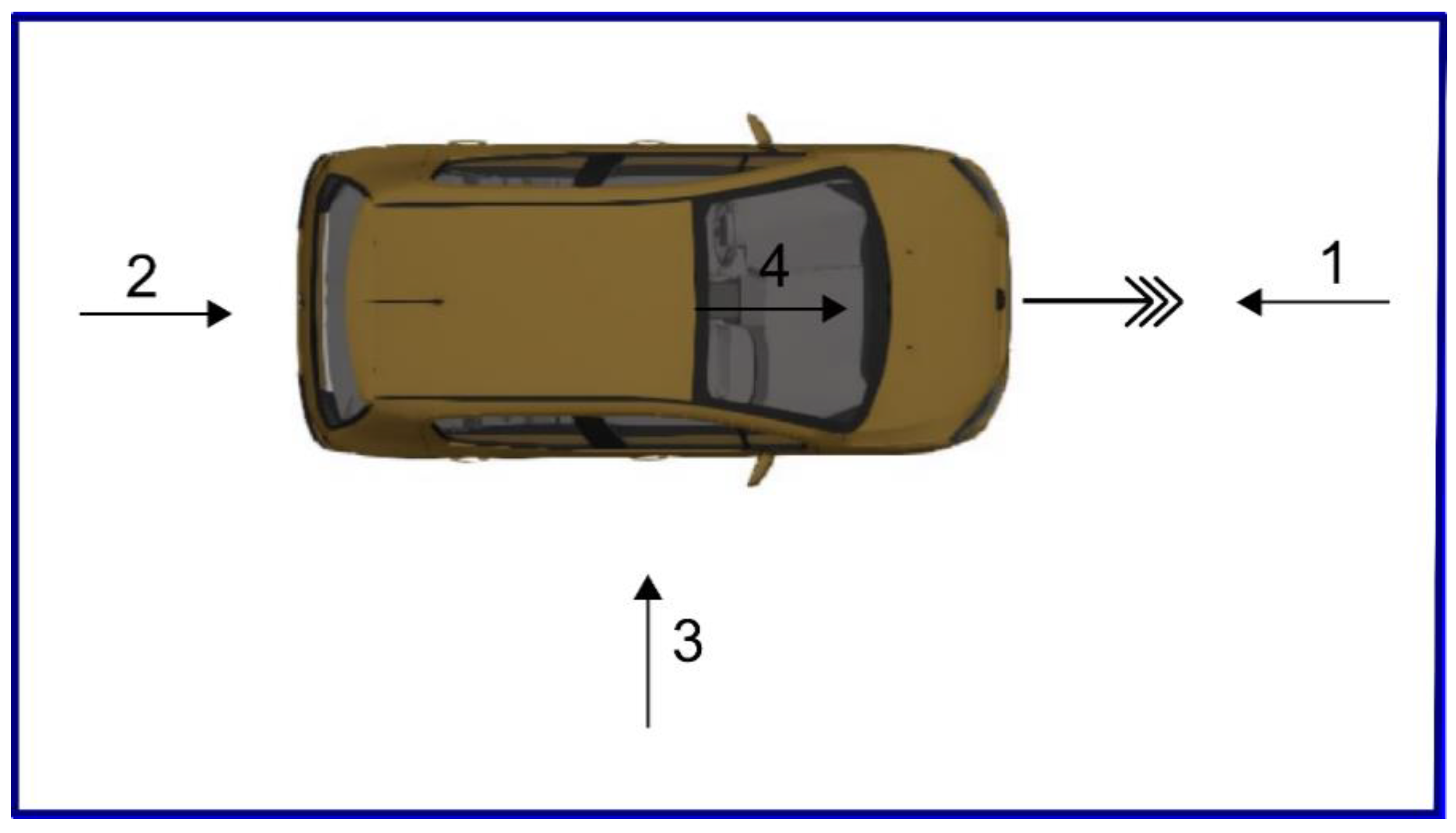
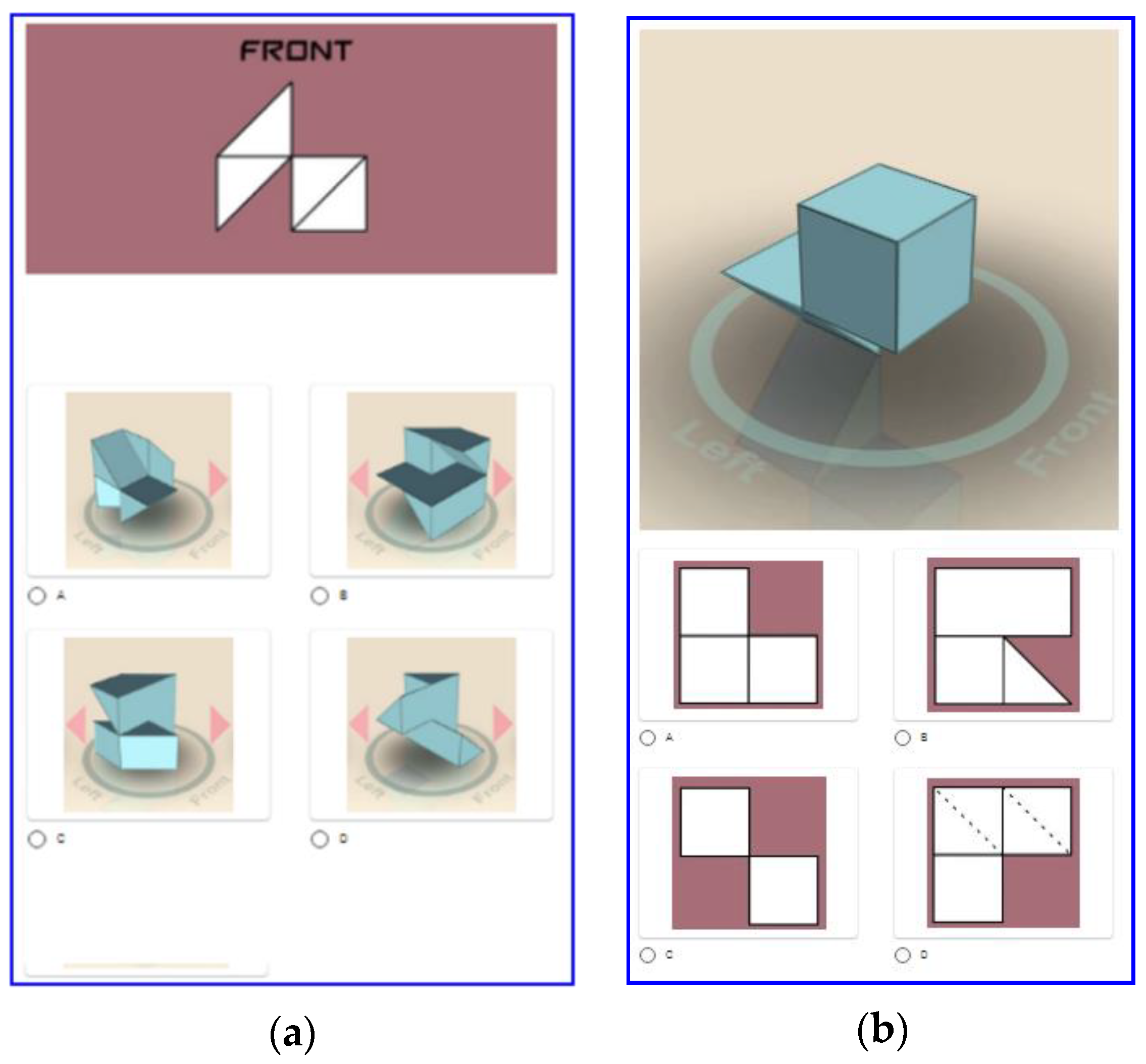
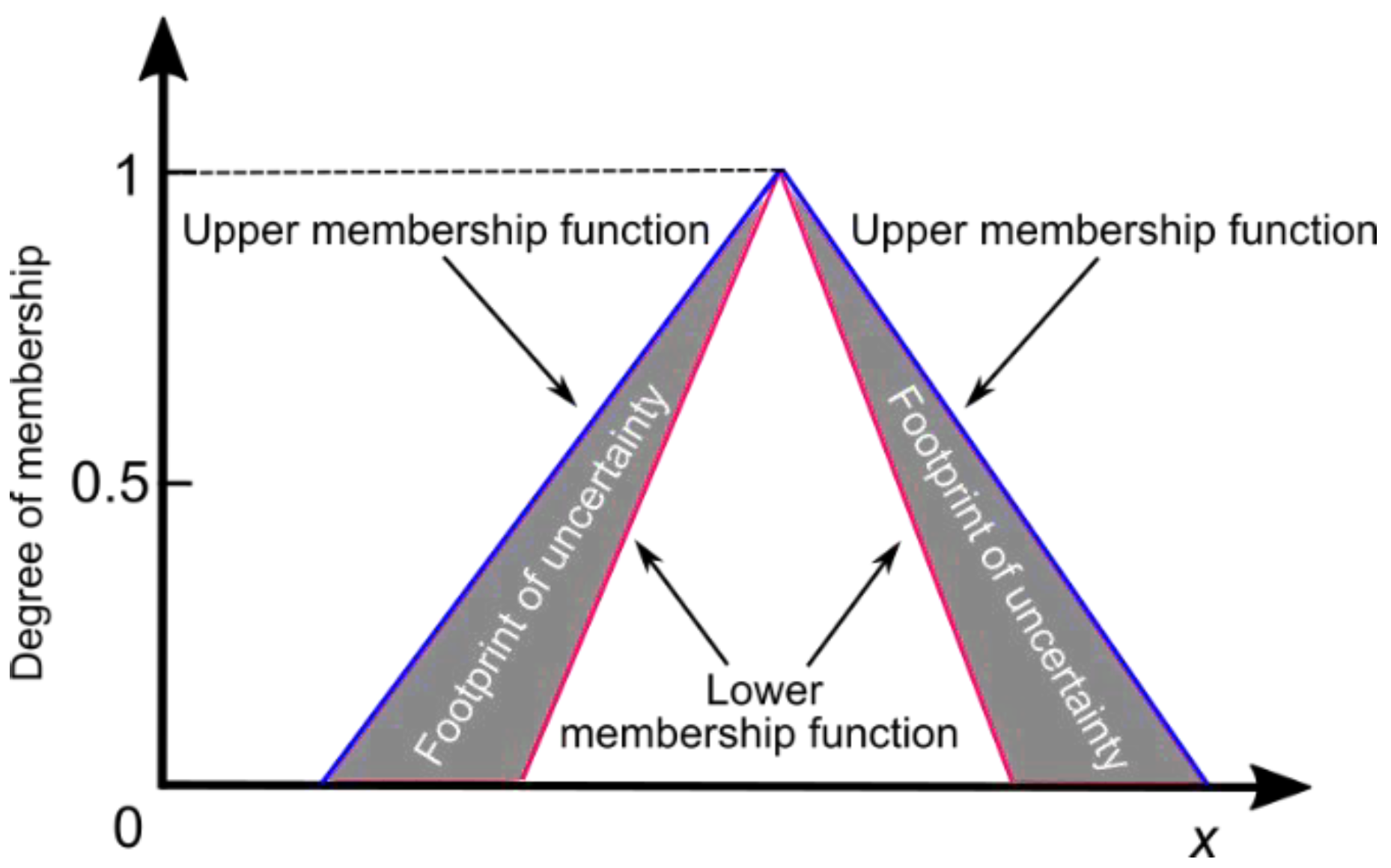


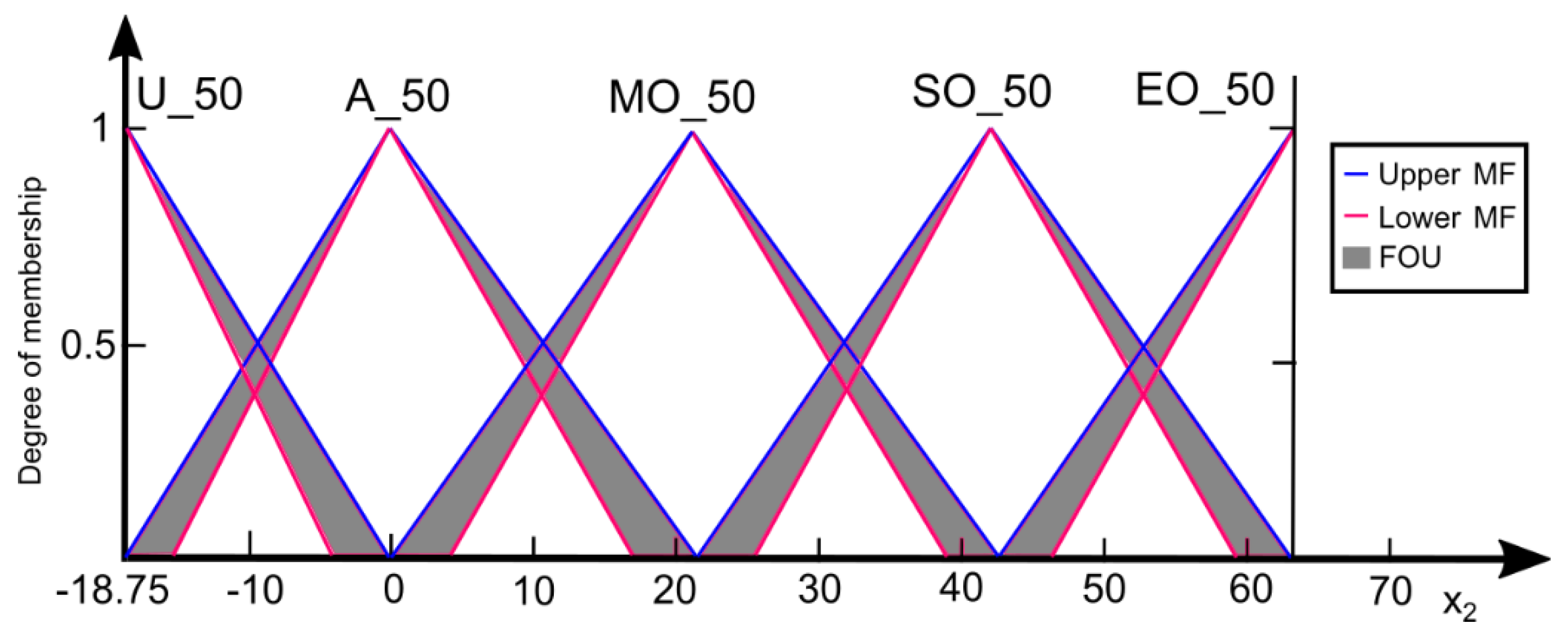
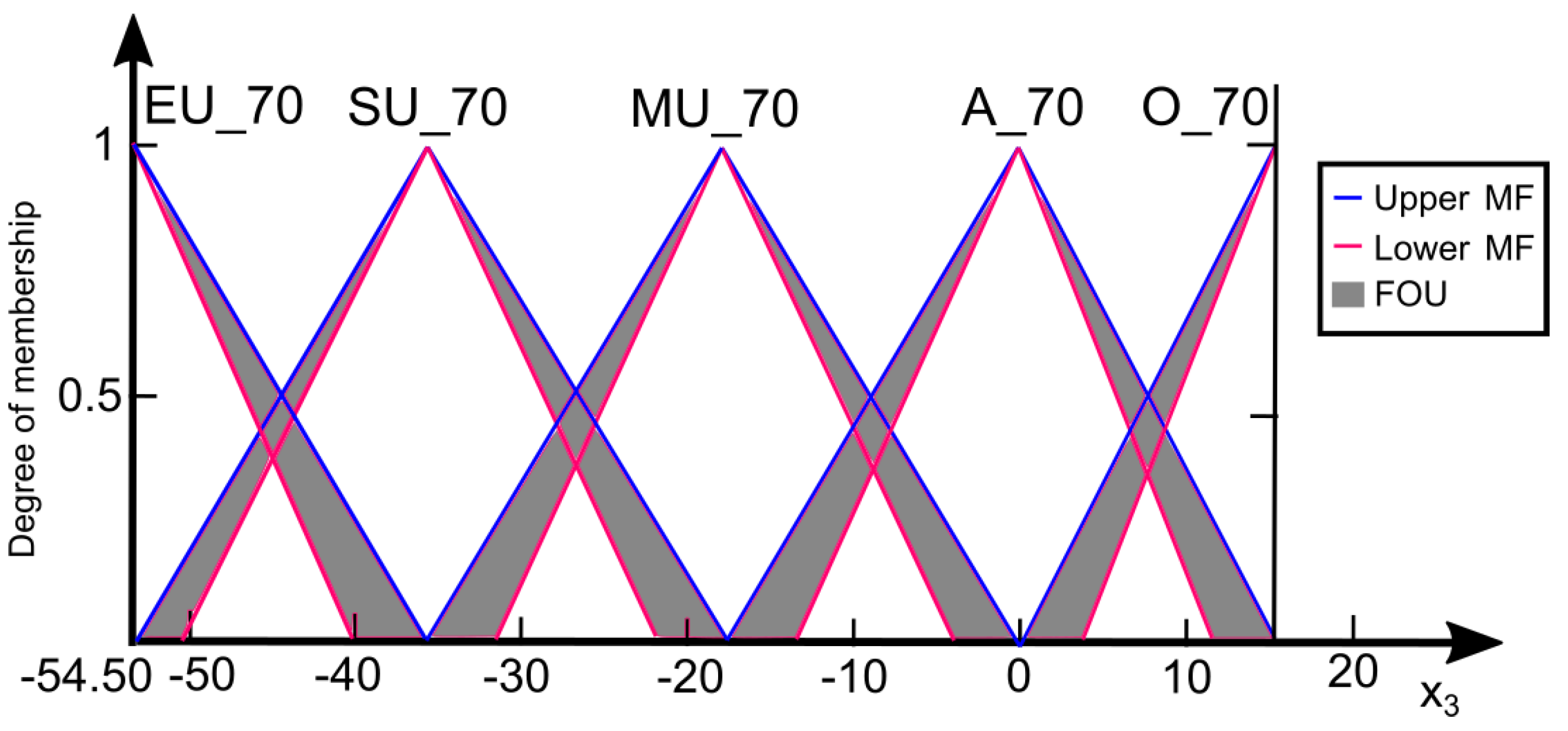


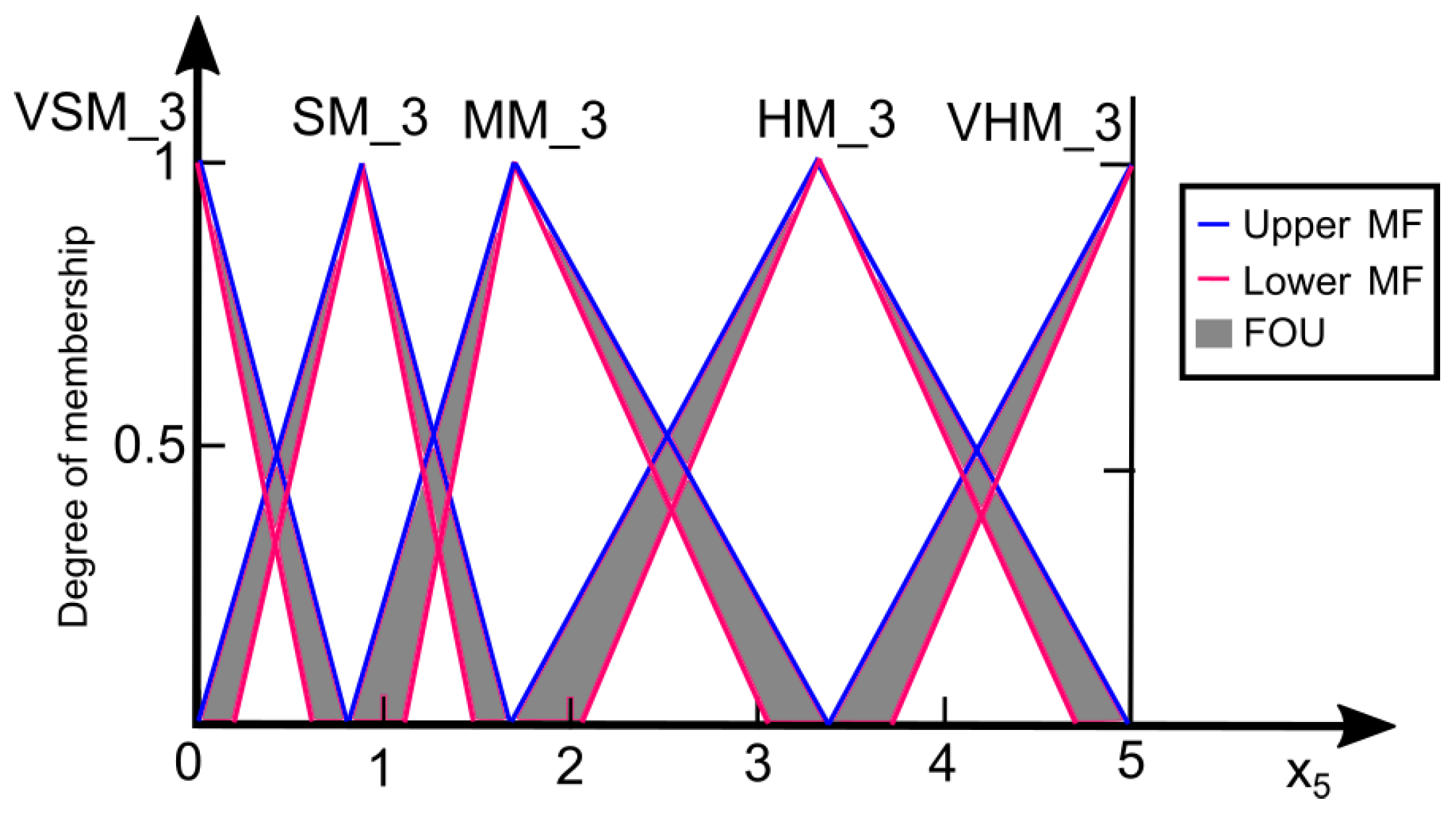
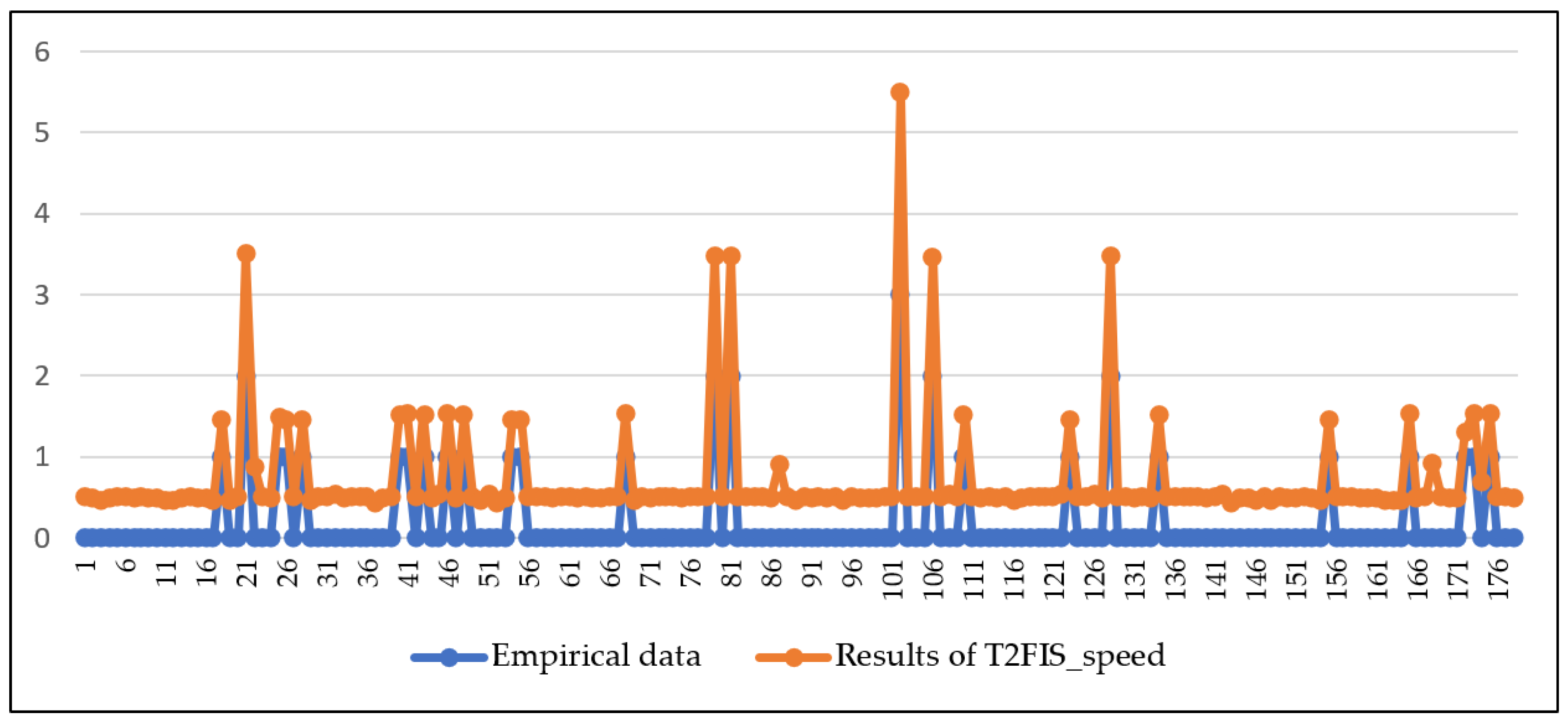
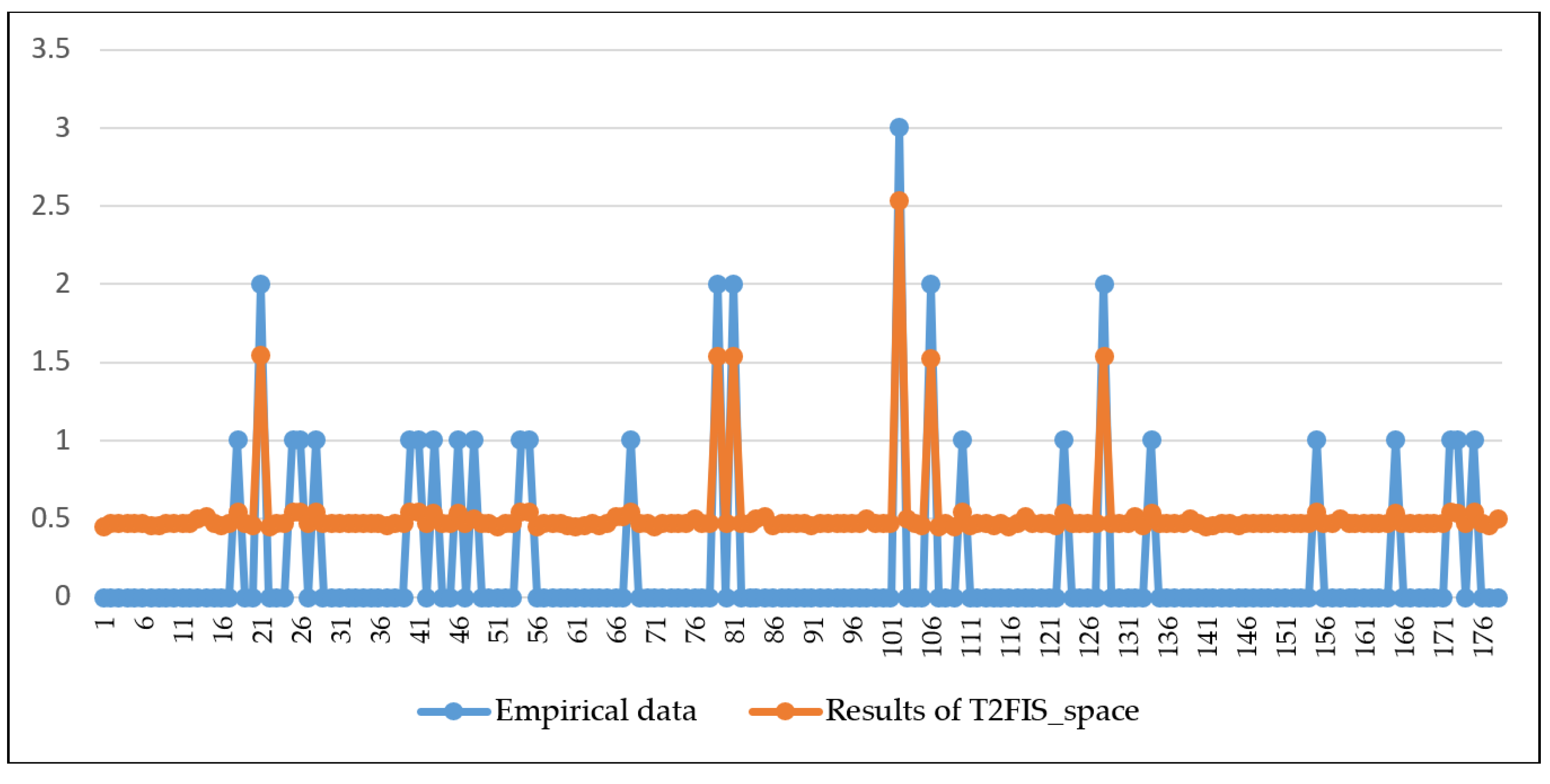
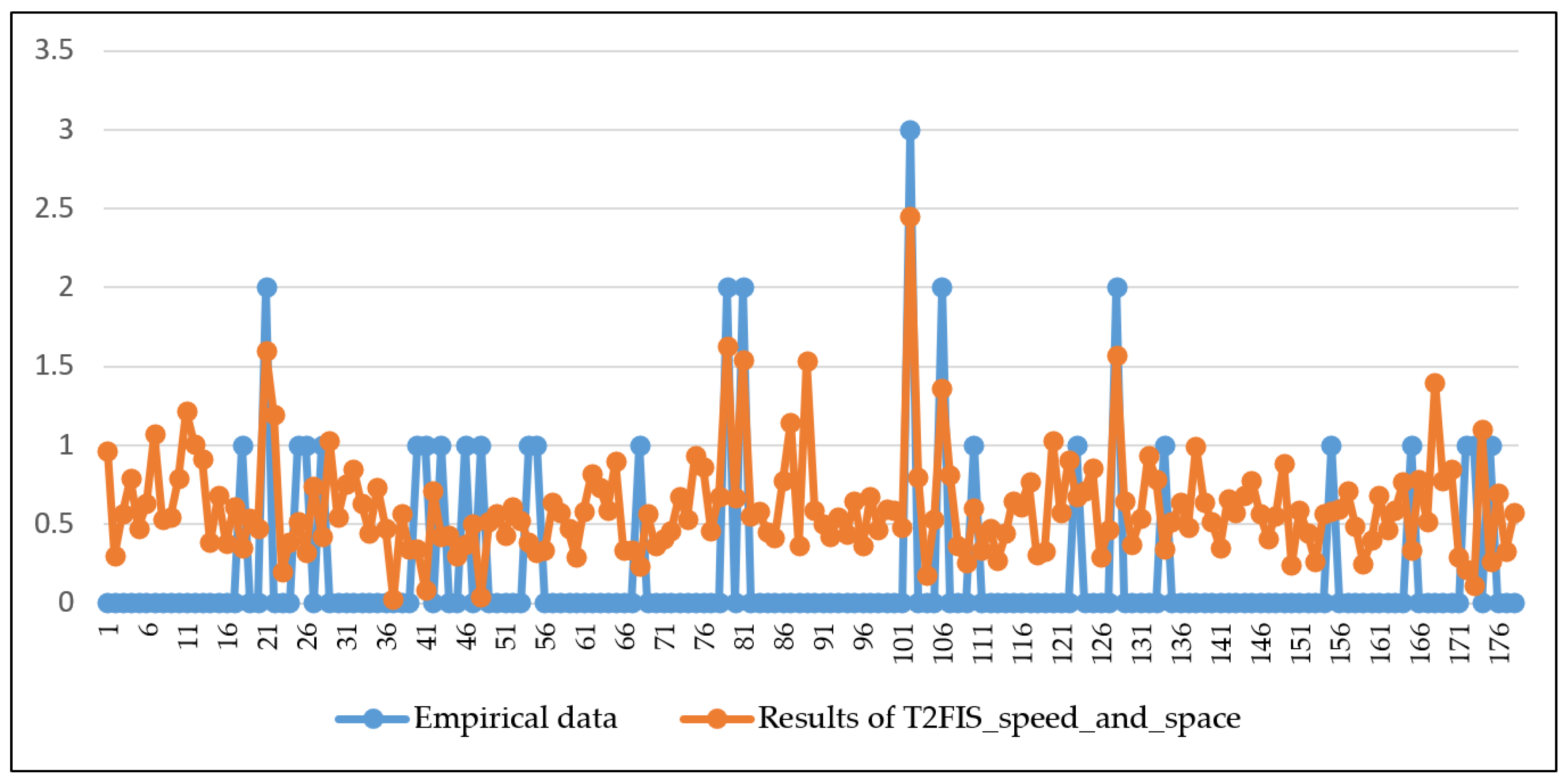

| Input Variable | Average Errors in Assessments from Four Different Positions [km/h] | |||
|---|---|---|---|---|
| Minimum | Mean | Maximum | Standard Deviation | |
| Average assessment of speed 30 km/h | −3.75 | 21.75 | 67.50 | 11.68 |
| Average assessment of speed 50 km/h | −18.75 | 13.57 | 62.50 | 13.51 |
| Average assessment of speed 70 km/h | −54.50 | −32.33 | 15.00 | 10.06 |
| Input Variable | Average Marks from the Space Assessments Tests | |||
|---|---|---|---|---|
| Minimum | Mean | Maximum | Standard Deviation | |
| Average assessment of 2D space | 0 | 1.81 | 5 | 1.12 |
| Average assessment of 3D space | 0 | 1.67 | 5 | 1.01 |
| D(Rule) | Serial No. of MF for Variable x1 | Serial No. of MF for Variable x2 | Serial No. of MF for Variable x3 | Serial No. of MF for Variable y |
|---|---|---|---|---|
| 1 | 1 | 1 | 1 | 1 |
| 0.42682 | 2 | 1 | 1 | 1 |
| 0.25945 | 2 | 1 | 2 | 1 |
| 0.54222 | 2 | 2 | 1 | 1 |
| 0.62963 | 2 | 2 | 2 | 1 |
| 0.29929 | 3 | 2 | 1 | 1 |
| 0.68531 | 3 | 2 | 2 | 1 |
| 0.47288 | 3 | 2 | 3 | 1 |
| 0.35178 | 3 | 3 | 1 | 1 |
| 0.85328 | 3 | 3 | 2 | 1 |
| 0.74074 | 3 | 3 | 3 | 1 |
| 0.33383 | 3 | 4 | 2 | 1 |
| 0.27160 | 3 | 4 | 3 | 1 |
| 0.24294 | 4 | 3 | 2 | 1 |
| 0.30423 | 4 | 3 | 3 | 1 |
| 0.48971 | 4 | 4 | 2 | 1 |
| 0.67901 | 4 | 4 | 3 | 1 |
| 0.50440 | 4 | 4 | 4 | 1 |
| 0.37940 | 4 | 5 | 3 | 1 |
| 0.65040 | 5 | 4 | 5 | 1 |
| 0.10539 | 5 | 5 | 3 | 2 |
| 0.72222 | 5 | 5 | 4 | 1 |
| D(Rule) | Serial No. of MF for Variable x4 | Serial No. of MF for Variable x5 | Serial No. of MF for Variable y |
|---|---|---|---|
| 1 | 1 | 1 | 1 |
| 0.79518 | 1 | 2 | 1 |
| 0.79640 | 1 | 3 | 1 |
| 0.80239 | 1 | 4 | 1 |
| 0.88888 | 2 | 1 | 1 |
| 0.70682 | 2 | 2 | 1 |
| 0.70791 | 2 | 3 | 1 |
| 0.71324 | 2 | 4 | 1 |
| 0.87500 | 3 | 1 | 1 |
| 0.69578 | 3 | 2 | 1 |
| 0.69685 | 3 | 3 | 1 |
| 0.70209 | 3 | 4 | 1 |
| 0.75000 | 4 | 1 | 1 |
| 0.59638 | 4 | 2 | 1 |
| 0.59730 | 4 | 3 | 1 |
| 0.60179 | 4 | 4 | 1 |
| 1 | 5 | 5 | 1 |
| T2FIS_Speed | T2FIS_Space | T2FIS_Speed_and_Space | |
|---|---|---|---|
| T2FIS_speed | - | ||
| T2FIS_space | 0.048 * | - | |
| T2FIS_speed_and_space | 0.059 | 0.049 * | - |
© 2020 by the authors. Licensee MDPI, Basel, Switzerland. This article is an open access article distributed under the terms and conditions of the Creative Commons Attribution (CC BY) license (http://creativecommons.org/licenses/by/4.0/).
Share and Cite
Čubranić-Dobrodolac, M.; Švadlenka, L.; Čičević, S.; Trifunović, A.; Dobrodolac, M. Using the Interval Type-2 Fuzzy Inference Systems to Compare the Impact of Speed and Space Perception on the Occurrence of Road Traffic Accidents. Mathematics 2020, 8, 1548. https://doi.org/10.3390/math8091548
Čubranić-Dobrodolac M, Švadlenka L, Čičević S, Trifunović A, Dobrodolac M. Using the Interval Type-2 Fuzzy Inference Systems to Compare the Impact of Speed and Space Perception on the Occurrence of Road Traffic Accidents. Mathematics. 2020; 8(9):1548. https://doi.org/10.3390/math8091548
Chicago/Turabian StyleČubranić-Dobrodolac, Marjana, Libor Švadlenka, Svetlana Čičević, Aleksandar Trifunović, and Momčilo Dobrodolac. 2020. "Using the Interval Type-2 Fuzzy Inference Systems to Compare the Impact of Speed and Space Perception on the Occurrence of Road Traffic Accidents" Mathematics 8, no. 9: 1548. https://doi.org/10.3390/math8091548
APA StyleČubranić-Dobrodolac, M., Švadlenka, L., Čičević, S., Trifunović, A., & Dobrodolac, M. (2020). Using the Interval Type-2 Fuzzy Inference Systems to Compare the Impact of Speed and Space Perception on the Occurrence of Road Traffic Accidents. Mathematics, 8(9), 1548. https://doi.org/10.3390/math8091548







